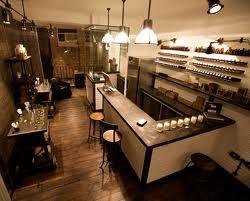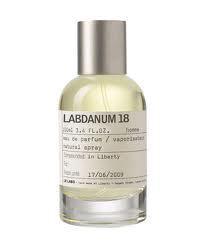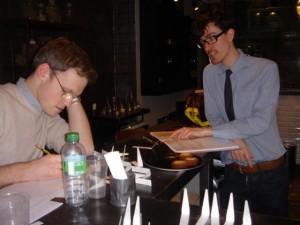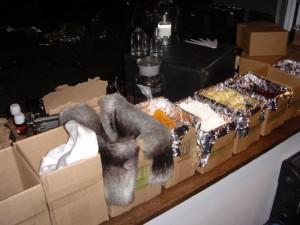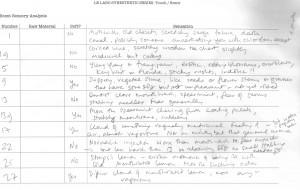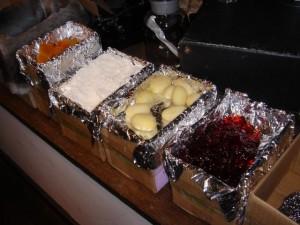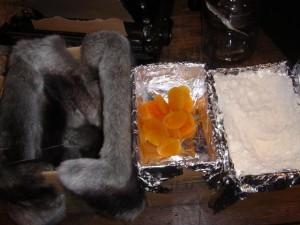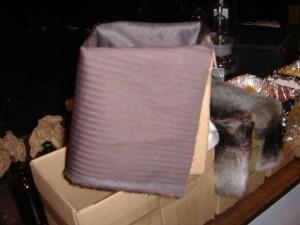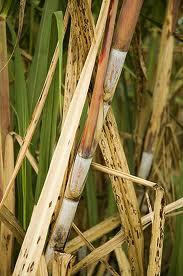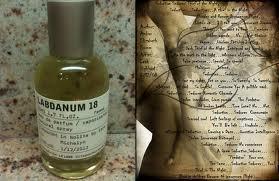Le Labo via marylebonevillage.com
When I think of Le Labo perfumes, the first image that comes to mind is their pared down, clinical looking bottles. They wouldn’t look out of place on a chemist’s shelf, frankly, next to the chloroform or the hydrogen peroxide. Or in a lab, indeed – I guess there is a bit of a clue in the name. But now I think of it, I once owned a bottle of lavender scented ironing water that was not dissimilar in shape, as are those pump dispenser handwash bottles that seem to have largely replaced soap these days – from the likes of Bayliss & Harding – or Molton Brown, if you are feeling flush. So there is a precedent for scented products to be contained in apothecary-style bottles, but the ones from Le Labo are unquestionably Spartan and plain – sensorily deprived, if you will.
liberty.co.uk
So I was intrigued when EIC of www.cafleurebon.com Michelyn Camen tipped me off about Le Labo’s series of Synesthetic Workshops in London, and asked if I would be interested in attending one, and covering it for Cafleurebon. Well, I thought, in contrast to the minimalism of the bottle design, it was clear from the name of these events that sensory perceptions were going to be the order of the day! My curiosity aroused, I turned to the dictionary to clarify the precise meaning of synesthesia:
“Synaesthesia (also spelled synesthesia); from the Greek (syn-) �union�, and (aesthesis) �sensation�; is the neurological mixing of the senses. A synaesthete may, for example, hear colors, see sounds, and taste tactile sensations. Although considered a symptom of autism, it is by no means exclusive to those with autism. Synaesthesia is a common effect of some hallucinogenic drugs such as LSD or mescaline.”
A symptom of autism, eh? Given my encyclopaedic recall of birthdays (as noted in my February post), a synesthetic workshop sounded as though it was made for me. Though I don’t fit the drug user profile, obviously.
The workshops are the brainchild of “synesthetic provocateur” Nicola Pozzani, who has an MA in Sensory Marketing and Communication from the Università dell’Immagine in Milan, where he studied perfume science for two years under Jean-Claude Ellena. Nicola likened the style of his degree course to that of Montessori schools, namely with less emphasis on academia and more on an interactive sensory approach, and the workshop reflected this. His varied career since has included a stint as Project Manager at Symrise NYC (where he worked for Fabrice Penot, one of the co-founders of Le Labo ), a creative consultancy role at LVMH, a sales position at L’Artisan Parfumeur, and – most recently – a couple of jobs teaching English as a foreign language, at which I also tried my hand some 30 years ago…!
John and Nicola
The stated aim of the workshops was for students “to engage in practical sensory exercises…by doing so they will become actively involved in experiencing the connections between perfume and other sensations. This synesthetic experience will help them expand their knowledge of scent.
Furthermore, by exploring the sensations perfume can transmit, students will have the chance to experience perfume as an art form, as a creative language, and become aware of the creative scenarios that lay behind fragrance creation. They will eventually become more sensitive to scent and gain a newly discovered perception of perfume.”
In my case, I attended the second workshop in the series – on smell and its relationship to TOUCH.
I arrived at the Le Labo store in Devonshire Road some 25 minutes early, and though I spotted some people already inside – who turned out to be the other attendees who were even earlier than me! – I decided to have a nosey in Marylebone’s very classy branch of Oxfam, before nipping into Starbucks to buy an emergency twin pack of ginger biscuits. I needn’t have worried, as Le Labo served up some delicious little soft centre cakes and chocolates at half time, neatly tied in to the theme of the event…
The Le Labo store itself looks like a rather sparsely appointed hotel bar or a kitchen room-set at IKEA. As the last man in, I received the short straw – or the short stool to be precise – which meant I was perched a little awkwardly at the counter, like a child who has been allowed to eat at the grown ups’ table.
There were four other people at my session: three women and a man. I didn’t catch all their bios, but one woman tasted whisky as part of her job – nice work if you can get it! Both she and the friend she’d come with had apparently married their husbands because they liked the way they smelt (as in their natural odour), which was pretty remarkable. No mention of the usual suspects of sense of humour, nice eyes, own house or head of hair. So for that scent-orientated pair too, the workshop was right up their alley. The third woman was in banking, while the lone man worked in marketing for a skin care brand.
Introductions over, Nicola explained that we would be learning about Le Labo’s range of raw perfumery materials from its so-called “Olfactionary” via a tactile approach, rather than the traditional families of “woody”, “citrus” etc. The first part of the workshop consisted of smelling fifteen oils in isolation – we weren't told what these were till the very end of the session. As we smelt each oil in turn, we wrote down on a blank sheet the sensations they evoked, in particular from the perspective of softness. We had to say if each one was soft or not, and if it was, what type of soft: silky, squishy, foamy, sticky, slippery, yielding in some other way etc – which was quite hard in some cases. Nicola asked us if we were actually “touching” the scents in our minds, and the consensus of the group was that we were smelling something that connoted a tactile sensation ie “smelling touch” rather than having a directly tactile perception. As you can see, there were moments like this where it all got a bit deep and philosophical…
Now I was surprised at how many of these oils I disliked in their pure state, even though I knew I would probably love many of them in a finished formulation. This in itself was a little disorientating. Predictably, the scents also changed the longer they were on the blotters, and several of us revised our impressions later on. I should perhaps not say too much about what we smelt, in case it acts as a spoiler for anyone thinking of attending a later workshop in the series, but suffice to say that I only correctly guessed what a few of the materials were: I got bergamot muddled up with lemon, and failed to identify the two roses in the range (an essential oil and an absolute). I didn’t consider these to be soft, either: the absolute reminded me of corked wine and a wooden tea chest, while the essential oil conjured up mothballs in old closets, scratchy serge fabric – and even the sensation of being forcibly anaesthetised with chloroform (“except it smells”, I wrote). The apothecary bottle shape was clearly popping up in my subsconscious again…
At this point we still didn’t know what we had smelt, nor had we shared our perceptions of each raw material with the group. There was a second stage to this exercise coming along, for which we needed to keep our sensory perceptions free from outside influences.
Meanwhile, the central part of the workshop involved feeling a number of objects in boxes blindfolded, all of which were soft in varying degrees. We weren't asked to guess what they were, but of course we were furiously doing so privately. I was reasonably successful at identifying these tactile sensations, although the sticky maggots of my imagination turned out to be jam! There were all sorts of soft fabrics too, like silk, velvet, cotton, fur, brocade and wool, and the other soft objects included foam, cotton wool, sponges of all kinds from the bath variety to scouring pads, powder, a creamy blusher and – back on the edible theme – some dried apricots and gnocchi!
After we had removed our blindfolds and seen exactly what was in the boxes, we discussed why certain touch sensations were unpleasant, notably those involving food. We concluded that according to Western table manners, food is conventionally handled with cutlery, and although we might pick bits of food debris out of the plug hole in a sink when washing up, at that point food has been transformed into “waste” and so is distasteful to touch. The foodstuffs in the boxes were similarly out of their proper context, and thus provoked sensations of revulsion.
I have since caught up with one of the women in our group, and she told me how much she enjoyed this part of the workshop, and how underrated the sense of touch is in society. I think she has a point there, for as a nation we Brits are not much given to public displays of affection. The rummaging in boxes part was unashamedly physical and rather reminiscent of being a kid playing in a sandpit!
Then the final part of the exercise consisted of choosing our favourite scent from the earlier sampling on blotters, and describing it in even greater detail, relating it to one of the textures we had felt blind, and thinking of who the wearer might be, also the geographical setting, our relationship to the scene we were painting in our minds – in short a whole vignette of images and smells and tactile sensations that captured the essence of that particular scent in a synesthetic way.
tshirtstorehouse.com
I choose the scent I liked best from earlier – most aptly as it transpired – for I later learnt that it was vanillin, my favourite perfume note! The story it conjured up was as follows (warning – purple prose alert…):
“Gourmand vegetation, a field of some kind of canes or rushes – sappy, sticky, a bit minty and resinous. Pearls of sucrose resin oozing down the canes. I am in the West Indies somewhere, on my own and it is a warm day. The refreshing, cooling mintiness cuts the sweeter aspects. It is solitary scent, not comforting as such.”
I picked a sheeny tailored fabric as the closest fit to the “touch personality” of this fragrance, which was soft, but in a stiffly formal kind of way. My wearer was:
“Independent, adventurous, not particularly feminine, slightly outdoorsy, cool, capable, unflappable – maybe even a man”.
When the identity of the scent was revealed at the end, I realised that I had described a “detached vanilla”, the vanilla equivalent of Kipling’s cat that walked by itself, and that the wearer may in fact have been me…
The other four participants all chose different scents and wove different synesthetic stories around them. Nicola has since summarised the five as follows (the last one is mine!):
…Infinite and enveloping safety and a cup of Earl Grey Tea…
…Young, playful spontaneity and freedom over freshly cut grass…
…A wrapping and sweet totality with a fruity encounter…
…Comforting waxy memories from a mother’s apiary work…
…An independent traveller and her encounter with some soft plant…
The first image is especially interesting – it came from the man in our group, for whom bergamot oil unlocked powerful childhood memories of nurturing vapour from Earl Grey tea. His description was wonderfully fanciful and I cannot do it justice here, although I have written a note to myself that his chosen fabric was “velvet minus the folds”. He includes a snippet in his own account of the event in his blog, Rear Window, where he also refers to the rest of us as “older women”, which I guess we were!
“…before long I was floating in an infinite opaque sphere of warm liquid. A giant womb, devoid of gravity and boundaries. Le Labo and Pozzani's workshop managed to turn sniffing scent into a lucid hallucinogenic experience.”
Which brings us neatly back to synesthesia as the by-product of an acid trip…
flickr.com
Now one of the other women – who picked a rose oil which conjured up a beekeeper’s shed, and which she associated with a mature, confident, maternal woman with a quiet sexuality – made a quip about a possible covert research agenda on the part of Le Labo: "Okay, so I have defined your target audience for you!", as though we were in fact a self-funding focus group.
I’ll be honest and say that that thought also crossed my mind, but there was after all only one workshop dedicated to each sense, and very few of us in each one, plus we all chose a different scent to talk about. And when there was briefly time to share our thoughts on one another’s scent stories, it quickly became apparent that we were all over the map with our scent associations, so the only learning the company could have taken from it is that people’s synesthetic perceptions are deeply – and often wildly – personal!
The workshop overran by an hour, so regrettably people started leaving at staggered intervals from 6pm onwards, and there was only me and the tea chap left at the end. There was just enough time for Nicola to reveal the names of the oils we had smelt on the blotters, but no chance really to correlate these with Le Labo’s range of perfumes. I wouldn’t have minded knowing which oils were in which of their scents, and Nicola did tell me in passing that vanillin was in Labdanum 18, so I chose that as my complimentary sample on the night. There again, you could argue that it was good that there was no covert sales agenda either that sought to use the workshops as a vehicle to promote Le Labo’s line.
So what did I take from this rich sensory experience? Well, for starters it was a great way to meet fellow scent enthusiasts. I also discovered a new perfume love in Labdanum 18 – of which Le Labo have since kindly gifted me a bottle – and confirmed that my nose may be rubbish at identifying things blind, but my hands are much better. And somewhere amongst the nice – and the not so congenial – smells and textures, amongst the feverish imaginings and the synesthetic mayhem, I also learnt that I find my way back to vanilla like a homing pigeon, and that it is the perfumery note that most smells like “me”…
And finally, my other half, known to some readers as Mr Bonkers, caught a whiff of Labdanum 18 as I walked past the sitting room this evening. His dislike of perfume is vehemently comprehensive as a rule, but he took me completely by surprise with this remark: “Of all the perfumes you have made me smell, that one is the most like ice cream. It’s quite nice, actually.”
Well, well – and it has vanilla in it, of course…Have they had the TASTE workshop yet, I wonder? Only he’s clearly a natural at this synesthesia lark!
–Vanessa Musson, Contributor
The draw is for a Le Labo Discovery Kit which consists of three 5mL samples of Labdanum 18, Rose 31, and Neroli 36. Please leave a comment on your favorite Le Labo fragrance to be eligible. Draw closes March 27, 2011

